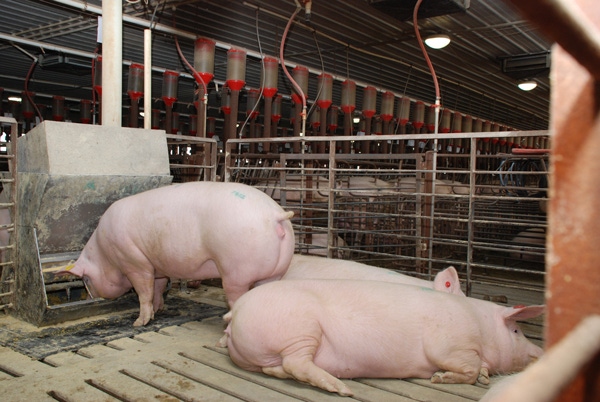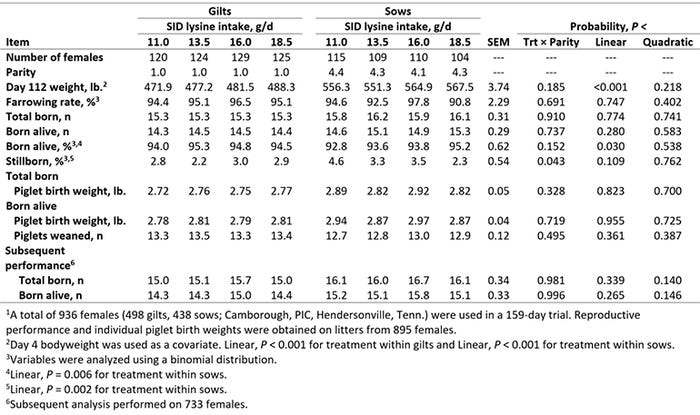In sows, but not in gilts, increasing lysine intake may increase the number of piglets born alive by reducing the number of stillborn pigs.
September 27, 2018

By Lori Thomas, Lauren Herd, Robert Goodband, Mike Tokach, Steve Dritz, Jason Woodworth and Joel DeRouchey, Kansas State University; Marcio Gonçalves, PIC; and Dan Jones, ADM
Sow herds continue to increase in productivity, with some of today’s most prolific females producing more than 33 pigs per sow per year. One of the major concerns with this increase in litter size is the resulting decrease in piglet birth weight. This has led to a growing emphasis on redefining nutrient requirements for gestating sows, specifically dietary lysine. Lysine is the first limiting amino acid in corn and soybean meal-based diets and can have a major impact on subsequent reproductive performance.
However, data is limited pertaining to dietary lysine requirements in gestation. Thus, the current study aimed to evaluate the effect of standardized ileal digestible lysine intake during gestation on weight gain and reproductive performance of gilts and sows.
The study was conducted at a commercial sow farm in central Nebraska with four levels of increasing digestible lysine (11, 13.5, 16, 18.5 grams per day). Many gestation diets formulated today would provide about 13 grams of digestible lysine. A total of 936 females (Camborough, PIC, Hendersonville, Tenn.) were group-housed from Day 4 to 112 of gestation and individually fed with electronic sow feeders (Nedap Velos, Gronelo, Netherlands). On Day 4 of gestation, females were weighed, backfat measurements were collected and females were allotted to one of four dietary treatments. Gilts and sows received 4.6 and 5.1 pounds per day, respectively, of feed throughout their entire gestation period. On Day 112 of gestation, as females were moved into the farrowing house, they were weighed and backfat measurements were collected. Individual piglet birth weights were obtained within 12 hours of birth on litters from 895 females. Wean-to-estrus interval, farrowing rate and subsequent litter size were also collected. Data was divided into two parity groups: gilts and sows (Parity 2 and greater).
Increasing standardized ileal digestible lysine increased body weight at Day 112 of gestation within each parity group, with gilts and sows consuming 18 grams per day SID Lys weighing 16 and 11 pounds more than gilts and sows consuming 11 grams per day SID Lys. However, increasing digestible lysine allowance had no effect on backfat at day 112 of gestation. On average, gilts and sows gained 1.8 and 3.4 millimeters, respectively of backfat throughout gestation. These results showing increased weight gain without backfat gain suggest that females deposited more lean tissue with increasing lysine intake.

Table 1: Effects of increasing standardized ileal digestible lysine intake in gestation on sow performance and piglet birth weight1
Increasing lysine had no effect on farrowing rate or total born. Average total born for gilts and sows was 15.3 and 16.0. Increasing lysine intake had no effect on the number of piglets born alive in gilts; however, in sows, the percentage of piglets born alive increased with increasing lysine intake. This was attributed to a decrease in the percentage of stillborn pigs. There were no differences observed among treatments groups for the percentage of mummified fetuses in gilts or sows. Increasing standardized ileal digestible lysine had no effect on total born piglet birth weight or born alive piglet birth weight within this study. Born alive piglet birth weight averaged 2.8 pounds for gilts and 2.9 pounds for sows, respectively. There were no differences observed in farrowing rate or litter size in the subsequent reproductive cycle.
In summary, these results demonstrate that current standardized ileal digestible lysine intake in gestation increases gilt and sow weight gain, and this is likely through lean tissue deposition, because there were no differences in backfat depth. In sows, but not in gilts, increasing lysine intake may increase the number of piglets born alive by reducing the number of stillborn pigs. These findings suggest that 11 to 13 grams of standardized ileal digestible lysine appears to be adequate for gestating gilts and sows.
You May Also Like



